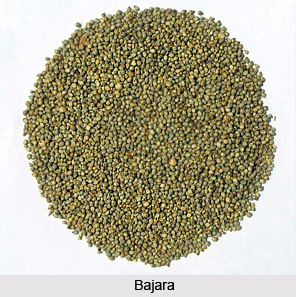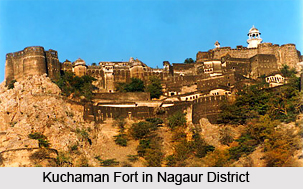 Economy of Nagaur District is primarily dependent on agriculture. Agriculture is the main occupation of a majority of the population of the Nagaur District. Bajra, wheat, jowar, til, barley and pulses are the major crops of the Nagaur District. The other crops of the district are taramira, rape and mustard seeds and gram. Kharif crops constitute the bulk of the food production in the district since agricultural activities are mostly dependent on the monsoons. Kharif crops include bajara, jowar, moong, choula, rice, groundnut, til and guar. Rabi crops are usually sown in November whereas Kharif crops are sown with the beginning of the first rains in July.
Economy of Nagaur District is primarily dependent on agriculture. Agriculture is the main occupation of a majority of the population of the Nagaur District. Bajra, wheat, jowar, til, barley and pulses are the major crops of the Nagaur District. The other crops of the district are taramira, rape and mustard seeds and gram. Kharif crops constitute the bulk of the food production in the district since agricultural activities are mostly dependent on the monsoons. Kharif crops include bajara, jowar, moong, choula, rice, groundnut, til and guar. Rabi crops are usually sown in November whereas Kharif crops are sown with the beginning of the first rains in July.
The industrial scenario, though not much developed, is slowly moving along the path of development. Earlier, there were minor manufacturers having a market in the neighbouring areas while for the rest of the trades there were hereditary artisans like carpenters, blacksmiths, potters, goldsmiths and other artisans to meet the local demands. Even after independence, Nagaur district has been practically industrially backward on account of the lack of exploitation of natural resources and under developed infrastructural facilities. Now the industrial climate is changing and a number of incentives and concessions are being offered to prospective entrepreneurs and they are looking forward to establish their units in the district.
Industrial units with a fixed capital investment of Rs. 5 crore and above are categorised as large scale industries. There are seven large and medium scale industries which exist in Nagaur district. Inspired by the incentives of the Government, the growth of small scale industries in the district has been quite fast. The major units covered by the small scale sector are mainly food-based industries, agriculture-based industries etc. Some of these units are old and traditional industries. In the recent years, demand and resource-based industries have also been coming up.
Industrial Areas
In Nagaur district, Rajasthan state Industrial Development and Investment Corporation Limited (RIICO) has developed industrial areas and these are located at Nagaur, Merta and Makarana. The district also has three industrial areas of District Industrial Centre (DIC). The principle trade centres of the district are Nagaur, Merta, Nawa, Ladnun, Jayal, Didwana, Parbatsar, Makarana, Degana and Kuchaman city and a number of Krishi Upaj Mandies areas which are also coming up in the district for marketing facilities of agriculture products. Prominent Krishi Upaj Mandies are Nagaur, Merta, Degana and Kuchaman city.
Khadi and Village Industries
The Khadi and Village Industries of the district include leather, tanning and manufacture of leather goods, weaving of cloths, woollen carpets, soap, furniture, rope making etc. Besides, the traditional blacksmiths, carpenters and potters etc. are also seen in most parts of the district. The development of village industries has an important place in the development plan of the state. These have been getting impetus through incentives, mainly in the form of loans being provided by Rajasthan Khadi Gramodyog Board, Rajasthan Financial Corporation, etc.
 Hand Tools Industry
Hand Tools Industry
The district of Nagaur claims a certain superiority in the field of hand-tools. Hand-tools Industry has flourished in and around Nagaur over the years. The industry peers into the past, dating almost back 600 years. About 300 types of hand-tools are manufactured catering to the requirements of a wide range of people, from gold-smiths to aeroplane engineers. Though the iron industry has undergone drastic changes, the hand-tools industry remained unchallenged and unmatched. The demand of these hand made tools always witnessed a growing trend. Hand Tools Design, Development and Training Centre (HTDDTC) is engaged in motivating more units to come up.
Salt Industry
Nagaur district is also an important salt producing area, Nawa and Deedwana tehsils being the major salt producing zones. Moreover, the Sambhar area (although forming part of the Jaipur district) is quite close to the salt belt of the Nagaur district. The industries based on common salt area and local resources could sustain, inter-alia, the following kind of plants: Caustic Soda Plant, Soda ash plant, Chlorine gas plant, sodium sulphate plant, iodised salt and refinery.
Gypsum
Nagaur district is very rich in gypsum deposits with Nagaur, Bhadwasi, Bhadana and Manglod being particularly good in Gypsum production. The reserves were estimated to be 952 million tones with 81 percent content and above by the Geographical Survey of India. A substantial part of the gypsum produced hare has been supplied to the Sindri fertilizer factory in Bihar. It has also found its way to Haryana, after primary grinding. An industrial complex in Nagaur, based on gypsum, along with ancillaries could be a major employment provider for the local population. The major Gypsum-based industries are - Cement plan (Portland), Fertilizer plant, Plaster of Paris plant, Potteries and moulds plant and Sulphuric acid plant.
Limestone
Best grade lime stone is found at Gotan, Mundwa, Kathoti and Ambali in the Nagaur district. Lime stone is also available in the Nagaur district in abundant quantity and the quality is reasonably good. Large reserves amounting to about 33 Million tonnes of high grade lime stone are found near Gotan. The deposit near Mundwa contains a reserve of about 1.19 million tones of high grade lime stone. The industries based on limestone as a resource are Quick Lime, Hydrated Lime, Precipitated chalk plants, Mineral Grinding plants and Cement plants.
Wolframite Tungesten
Wolfram (Wolframite) deposits are found in the Renwat hill at Degana. In this mineral, the tungstate of iron and manganese occurs, in the veins or lodes of granite and phtilites. Tungsten is especially suitable for use in the production of alloy steels and high speed cutting steals which retain hardness even when they are red hot. However for small quantities generally low grade materials have been mined. A reserve of the order of 3,400 tones has been established. Other minerals available in Nagaur district include sandstone. It is available almost every where in the district, but the best grades are available at Khatu in Deedwana tehsil where as many as 150 quarries already exist. Fairly good deposits of white clay are found near the village of Suradhana, Khajawana, Mundwa, Dhadhariya Khurd and at a number of other places in Merta Tehsil.
Apart from the mentioned industries, famous traditional crafts industries also flourish in the district of Nagaur. These include the Jatu Saree of Ren, the Bronze Industry of Nagaur, the Leather Mojari of Nagaur and the Durries of Tankla.



















